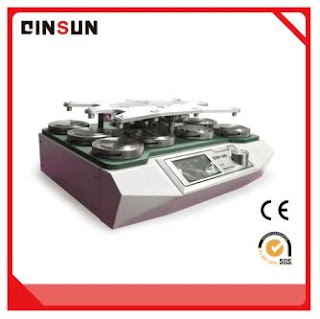Martindale Abrasion Tester Method
Significance and Use
1.1 Acceptance Testing—this test method is not considered satisfactory for acceptance testing of commercial shipments of fabric. The between-laboratory precision of this test method is poor and, because of the nature of abrasion testing itself, technicians frequently fail to obtain results in agreement on the same type of testing instrument, both within and between laboratories. Although this test method is not recommended for acceptance testing, it is useful because it is used widely, especially outside the United States.
1.1.1 In case of a dispute arising from differences in reported test results when using this test method for acceptance testing of commercial shipments, the purchaser and the supplier should conduct comparative tests to determine if there is a statistical bias between their laboratories. Competent statistical assistance is recommended for the investigation of bias. As a minimum, the two parties should take a group of test specimens that are as homogeneous as possible and that are from a lot of material of the type in question. The test specimens then should be assigned randomly in equal numbers to each laboratory for testing. The average results from the two laboratories should be compared using Students t-test for unpaired data and an acceptable probability level chosen by the two parties before the testing is begun. If a bias is found, either its cause must be found and corrected or the purchaser and the supplier must agree to interpret future test results in light of the known bias.
1.1.2 The resistance to abrasion also is affected greatly by the conditions of the tests, such as the nature of abradant; variable action of the abradant over the area of specimen abraded, the tension on the specimen, the pressure between the specimen and abradant, and the dimensional changes in the specimen.
1.1.3 Abrasion tests are all subject to variation due to changes in the abradant during specific tests. The abradant must be changed accordingly at frequent intervals or checked periodically against a standard. With disposable abradants, the abradant is used only once or changed after limited use. With permanent abradants that use hardened metal or equivalent surfaces, it is assumed that the abradant will not change appreciably in a specific series of tests, but obviously similar abradants used in different laboratories will not likely change at the same rate due to differences in usage. Permanent abradants also may change due to pick up of finishing or other material from test fabrics and must accordingly be cleaned at frequent intervals. The measurement of the relative amount of abrasion also may be affected by the method of evaluation and may be influenced by the judgment of the operator.
1.1.4 The resistance of textile materials to abrasion as measured on a testing machine in the laboratory is generally only one of several factors contributing to wear performance or durability as experienced in the actual use of the material. While “abrasion resistance” (often stated in terms of the number of cycles on a specified machine, using a specified technique to produce a specified degree or amount of abrasion) and “durability” (defined as the ability to withstand deterioration or wearing out in use, including the effects of abrasion) frequently are related, the relationship varies with different end uses, and different factors may be necessary in any calculation of predicted durability from specific abrasion data.
Qinsun Instruments Co., LTD!
Address:NO.258 Banting Road., Jiuting Town, Songjiang District, Shanghai
Address:NO.258 Banting Road., Jiuting Town, Songjiang District, Shanghai
learn more on http://www.abrasiontesters.com/martindale-abrasion-tester-method.html

没有评论:
发表评论